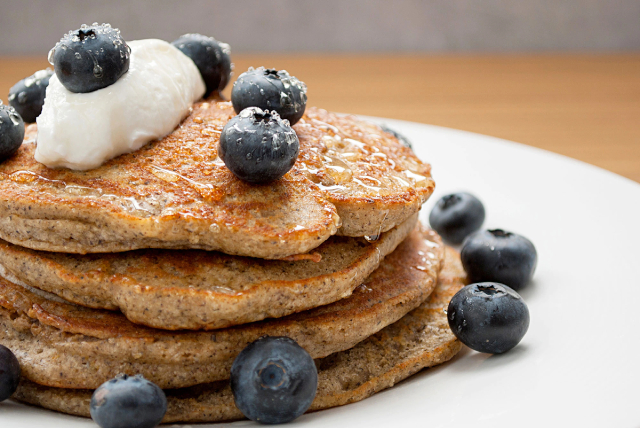The Pancake is one of the most popular breakfast foods in the Western World. But many folks don’t make them because the results they get aren’t as light and fluffy as they’d like. There are a number of ways to fix that!
 Substitute Buckwheat Flour for some of the plain flour to create a nutty, slightly
Substitute Buckwheat Flour for some of the plain flour to create a nutty, slightly
sweet Scottish-Canadian variant of the classic American Pancake.
I’m often asked how restaurants get their pancakes to come out so light and fluffy. And rise so high. Traditional pancake recipes are just fine if you know how to handle the batter. But there are also some ‘secret ingredients’ you can employ that will guarantee more-satisfying results.
Call ’em whatever you want…
Pancakes go by many different names depending on where you want to order them. In the US, you’ll find them billed variously as Hotcakes, Flapjacks, Griddle Cakes or Johnny Cakes. Mini Pancakes are often referred to as ‘Silver Dollars’.
Across the globe, American-stye pancakes can be found in many cuisines…
- The China, pancakes known as Bing rise super-high.
- Japan is famous for its Okonomiyaki – thick pancakes which may incorporate many different savoury ingredients.
- The Hotteok is Korea’s analogue of the American Pancake.
- India has more than 20 distinct cuisines. The Uttappam is a similar treat from Tamil cuisine in Southern India.
- Rice-based Pitha is the core style of a whole family of pancakes from Assam.
- Chatānmari is the Nepalese thick pancake, topped with meat and/or eggs.
- In South Africa, Plaatkoekies are close cousins of Silver Dollars.
- The Serabi of Indonesia is an easily recognisable relative of the American pancake.
- Bahn is a term used (with various slightly different spellings) across a number of Southeast Asian cuisines. But it always denotes an ultra-fluffy, snow white Pancake. Used most famously in the Korean Bahn Mi barbecue sandwich.
- The Philippines have made many foreign dishes their own – not the least of which is the Salukara.
- Latkes have been popularized the world over by the Jewish diaspora.
- Russian Oladyi are often topped with raisins or apples.
- Scottish Drop Scones may be a direct historical precursor of the American Pancake.
- English Crumpets are also closely related. Though a slight variation called the English Muffin is popular in North America.
And those are just the close cousins of the American-style, thick pancake. The French Crèpe and its relations cover even more ground, and are equally distributed around the world.
Make them right!
Which means knowing your leavening chemistry, and handling the batter with care.
Leavening magic
American-style pancakes are generally leavened with eggs and baking soda/powder. Baking Powder is a combination of soda and cream of tartar (dry acid). When liquid is added, the acid and the soda/powder react to make bubbles of carbon dioxide gas that leaven the recipe.
If you use plain soda, you must also add an acid component to the recipe. Some cooks use powder and add a squeeze of lemon juice to ensure lively leavening action. Don’t worry: the lemon juice (or plain white vinegar, if you prefer) won’t make the pancakes sour. The acid and the soda/powder react to make bubbles of carbon dioxide gas that leaven the batter.
Substitute Buttermilk for the water for a tangy classic that makes butter, fruit and Maple Syrup toppings shine! Buttermilk is acidic, so it will aid leavening.
The eggs work alongside the leavening agent(s) to hold the batter together so it doesn’t run all over the pan or grill producing a thin, tough pancake.
Handle with care
Use a wire whisk to combine the batter ingredients.
Do not beat the batter. You’ll knock all the leavening-gas bubbles out of it.
A good rule of thumb is to mix the batter until there are still a few lumps left. It’s no sin to leave them, and in fact they’ll help ensure a high, fluffy result. The lumps, as such, will disappear during frying.
Allow the batter to sit for a few minutes before pouring the first pancake. This allows the reaction between the soda and acid to produce the maximum amount of carbon dioxide bubbles and leaven the cakes optimally.
Gently pour the batter onto the cooking surface. Use a scoop for uniform-sized cakes, and to help control the shape of the product.
Turn the pancake only once, after small bubbles cover the upper surface, indicating the bottom and interior of the cake are cooked, or at least set.
NEVER, EVER press the pancake down with the spatula. You’re just cancelling out the leavening you’re supposed to be nurturing.
Place finished pancakes on a warmed platter and cover with a clean hand- or dish-towel.
Give it a try…
Just for good measure, my personal fave pancake recipe is here.
In any case, see what combination of the techniques imparted above give you the best results with your pancakes. And look up some of the other, international pancakes we’ve listed. Give some of them a try. You may establish a completely new breakfast (or lunch or dinner) tradition for your family!
~ Maggie J.

